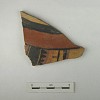
| Culture | Branch | Tradition | Ware | Type |
| Ancestral Pueblo: Greater Upper Rio Grande Valley | Southern Rio Grande | Middle Rio Grande | Middle-Southern Rio Grande Glaze Ware | Pottery Mound Glaze Polychrome |
Type Name: Pottery Mound Glaze Polychrome |
|
| Period: | 1350 A.D. - 1490 A.D. |
| Culture: | Ancestral Pueblo: Greater Upper Rio Grande Valley |
| Branch: | Southern Rio Grande |
| Tradition: | Middle Rio Grande |
| Ware: | Middle-Southern Rio Grande Glaze Ware |
Posted by C. Dean Wilson 2012
Pottery Mound Glaze Polychrome was described by Voll (1961). This type represents a very localized and distinct glaze ware type that appears to have been produced from the middle fourteenth to late fifteenth century. Pottery Mound Glaze Polychrome seems to reflect the culmination of a local glaze ware along with definite influences from the Hopi region and possibly other Western Pueblo groups. This is supported by the significant number of Hopi trade wares recovered from Pottery Mound. This type reflects some of the best examples of pottery produced by Pueblo potters, although this type was not ever widely traded, and was never even the dominant decorated type at Pottery Mound.
While the majority of rim sherds exhibit even walls well within the range defined for Glaze A types, a significant frequency of the rims are beveled, incurved or everted, and exhibit shapes similar to those described for Glaze C types. Vessels are well formed, slipped, and decorated. This type appears to have developed out of forms of San Clemente Glaze Polychrome and was largely produced at Pottery Mound and surrounding villages (Franklin 2007). This type represents an elaboration of polychrome forms where combinations of painted and slipped decorations resulted in combinations of three and even four colors including white, red, tan, and black on the same surface. The slip covers a paste that is red, sometimes with a gray core. At Pottery Mound this type was separated into two major variants, including one characterized by a chalky white slip and the other by a tan to buff slip (Franklin 2007). Designs are executed in a combination of black paint that is seldom runny or drippy, as well as in white and red slip clay. Despite the increased complexity of slip and design combinations employed, basic designs appear to be similar to those noted on earlier types including Aqua Fria Glaze-on Red and San Clemente Glaze Polychrome. Interior designs commonly include a combination of banded designs along with isolated motifs. An increase use of all-over designs is also evident. Overall designs involve the sweeping use of combinations of diagonal lines, and small irregular shaped lines filled with red paint. This type also exhibits an infrequent but increasing used of stylized designs including macaws and other birds and dragonflies. Combinations of styles noted in a minority of pottery assigned to this type is reminiscent of contemporary pottery produced on the Hopi Mesa. The various combinations of clay paste and slip as well as local basalt temper, reflects continual use of resources long utilized by potters in Pottery Mound area.
References:
Franklin, Hayward H.
2007 The Pottery of Pottery Mound. A Study of the 1979 UNM Field School Collection, Part 1: Typology and Chronology. Maxwell Museum Technical Series No. 5. University of New Mexico, Albuquerque.
Voll, Charles B.
1961 The Glaze Paint Ceramics of Pottery Mound, New Mexico. Masters thesis, University of New Mexico, Albuquerque.
Related Photos
 © New Mexico Office of Archaeological Studies, a division of the New Mexico Department of Cultural Affairs.
© New Mexico Office of Archaeological Studies, a division of the New Mexico Department of Cultural Affairs.
The Center for New Mexico Archaeology
7 Old Cochiti Road
Santa Fe, NM 87507
505-476-4404
Fax: 505-476-4448




